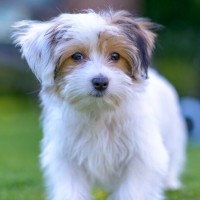Appearance of the Cavanese
|
| Cavaneses are toy-sized dogs, and the most common colors are fawn, tan, black and white. They can be one color or bi or tricolored, and their coats are short and soft and may have a wave or slight curl. The breed has a round head with a short muzzle and their ears tend to hang down. It will depend on which of the parent breeds your pet takes after most, but they are likely to have characteristics of both. The Cavanese's tail can be truncated or longer and tapered, and can curl. They have black noses and expressive eyes. Their legs are fairly short, but in proportion to their small bodies. |
Temperament of the Cavanese
|
| Cavaneses are intelligent, loyal dogs that make excellent pets and develop strong bonds with their families. They are energetic, playful dogs who get on well with children, although being quite small, it's important for adults to ensure that the dog is not handled too roughly by young children to avoid injury. They don't do well to be left alone for long periods and can develop separation anxiety which can lead to excessive barking. The breed gets on well with other pets, although it has been known to chase cats. Early socialization and training will be a good idea for your pet to avoid this. They are easy to train and will respond well to rewards and positive reinforcement. Despite their size, they need plenty of exercise, so daily walks will be a good idea as well as play sessions. This will prevent any bad behavior arising from boredom. They are not considered good guard dogs. |
Needs and activities of the Cavanese
|
| Despite their small size, Cavanese are energetic dogs that need at least 30 minutes of exercise a day to stay in shape. They'll love a walk on the beach or in the park, as well as ball games in a fenced-in yard. Your pet will behave better if it exercises regularly, as these breeds need mental stimulation to avoid boredom. A Cavanese will be happy in a house or apartment as long as it gets regular exercise. They shouldn't be left out in the cold for too long. They are more tolerant of warm weather than cold. |
Maintenance of the Cavanese
|
| Cavanese will need a moderate amount of grooming to keep them looking good. They should be brushed two or three times a week with a stiff bristle brush to remove loose hair and get rid of matting and dirt. Brushing also stimulates the skin, keeping the coat healthy. Depending on the parent breed your pet takes the most, you may need to trim the fur. Longer-haired dogs more like the Havanese may need their coats trimmed more often and brushed more regularly to get rid of any knots, but if your dog takes on the Cavalier King Charles Spaniel, you may simply need to trim the feet. Try brushing your dog's teeth every day and check for dirt in the ears, which can then be gently wiped away with the damp cotton ball, making sure the moisture doesn't stay in the ears. |









 English (United Kingdom)
English (United Kingdom)